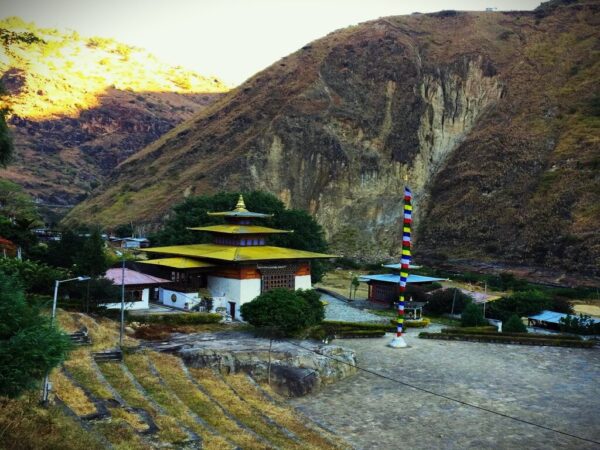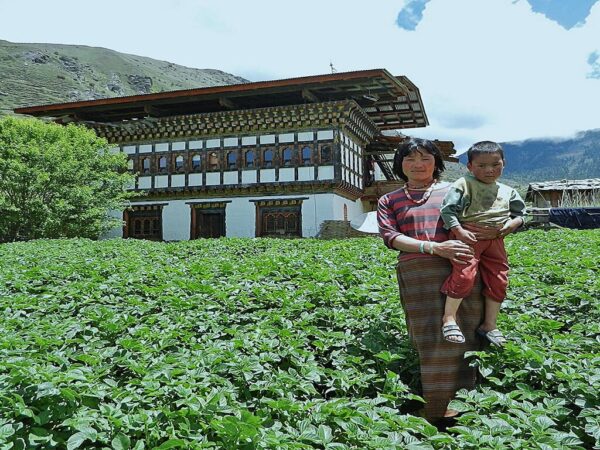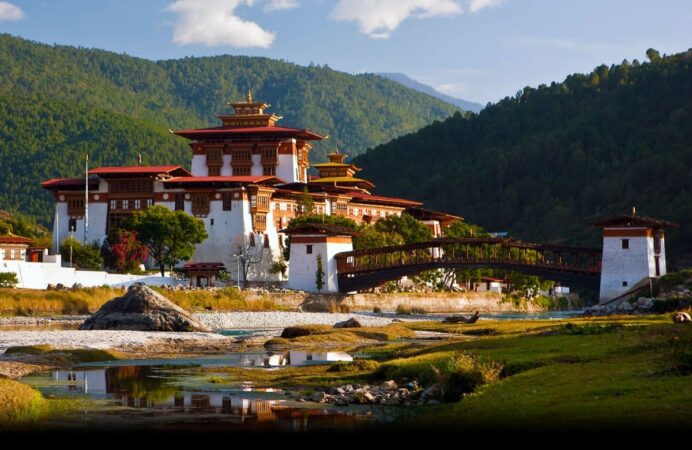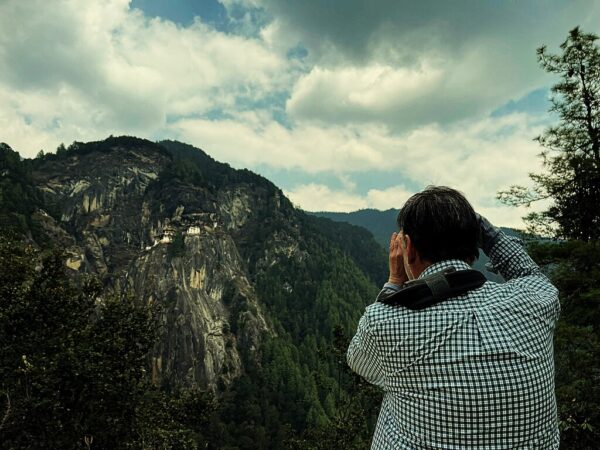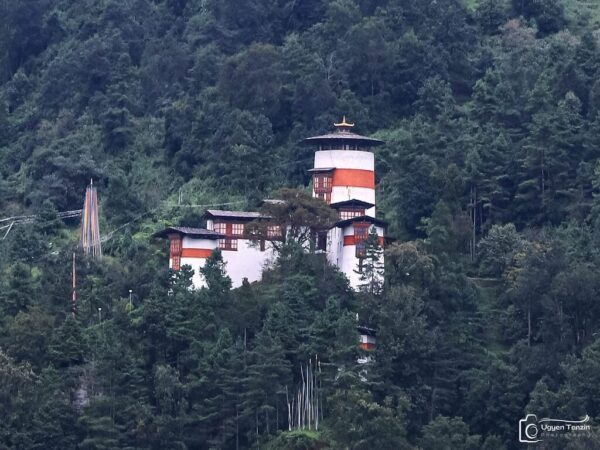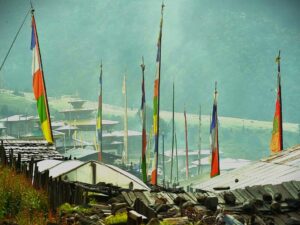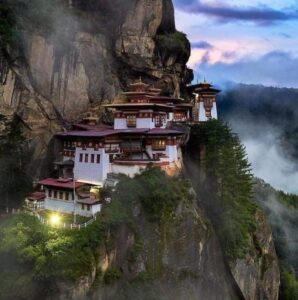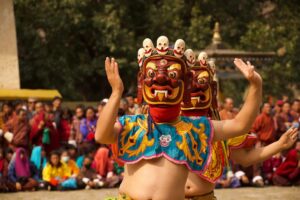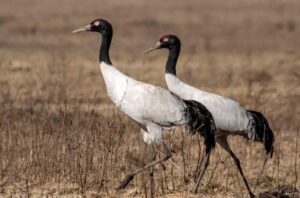Overview
Ideal for those who want to discover the true Bhutan, this ultimate cultural tour explores the cultural valleys of the west, spiritual central Bhutan & the rugged east. Journey Across Bhutan traverses’ incredible landscapes of high mountain passes with incredible Himalayan views, mixed forests, beautiful countryside and Alpine meadows rich with diverse flora and fauna. Beginning in the gentle valley of Paro, home to the famous Taktsang Monastery (Tiger’s Nest), you will visit ancient fortresses, sacred monasteries, remote temples, farm houses, palaces and monastic schools across the country to the eastern border town of Samdrup Dzongkhar. This is a special and unique tour is designed for the enthusiastic traveler with a longer holiday program in mind and a desire to discover the true Bhutan. Journey Across Bhutan can also operate Paro – Trashigang – Paro.
Included/Excluded
- All private excursions and transfers in a superior air-conditioned vehicle
- Local English-speaking guide/tour leader
- Experienced driver
- Accommodation in carefully selected, high-standard, government-approved hotels and guesthouses
- All meals in Bhutan
- All entrance fees and permits
- Personal expenses such as drinks, laundry, telephone calls, and tips
- Medical/Travel Insurance
Tour Plan
Day 01: Arrive - Paro
The flight to Paro is one of the most spectacular mountain flights in the world, with a constantly changing panorama of some of the highest mountains on earth. Our Himaquest Tour representative will meet you at Paro airport exit doors following customs formalities. After lunch enjoy afternoon sightseeing around Paro, including a visit to the Ta Dzong Museum housing many religious relics, works of art and handicrafts offering a great orientation into Bhutan’s historical, cultural, and religious past. Next, visit the Rimpong Dzong to see the painting of the great saint Milarepa. Dzong’s are large monasteries and district administrative centers, which were once strategic forts. Before dinner at the hotel there will be an orientation on Bhutanese etiquette by your guide. Overnight at your hotel in Paro.
Day 02: Paro
After breakfast hike to Taktsang Monastery. The walk of approximately 1.5 to 2 hours uphill takes you almost a kilometer above the Paro valley floor (for those who cannot hike we will arrange a horse for transfer up to cafeteria). The view of Taktsang Monastery built on a site of the cliff face 900 meters above the valley floor is a spectacular sight. The Monastery is an important pilgrim site for Buddhists. According to legend, the great Guru Rinpoche and his consort meditated in a cave here for three months when he brought the teachings of the Buddhist Dharma to Bhutan in the 8th Century. After meditation, they manifested themselves in the forms of Guru Dorji Drolo and a tigress to subdue demons in the valley below. The cave, where the monastery was later built is said to be the origin of Buddhism in Bhutan. Nearby there is a teahouse where you can stop for refreshments before returning to Paro for lunch. Afterwards drive to the ruins of the 17th Century Drukgyel Dzong, and 7th Century Kyichu Lhakhang, one of the 108 temples constructed by the Tibetan king Songtsen Gampo. Overnight at your hotel in Paro.
Day 03: Paro - Haa -Paro
Enjoy a day trip to the Haa Valley, located southwest of Paro, across the Chelela Pass. Covering an area of approximately 1,706 sq. km, Haa is one of Bhutan's smallest districts. Known for its pristine alpine forests and tranquil mountain peaks, this picturesque region is among the most beautiful and isolated in the kingdom. Opened to travelers only in 2022, it remains one of the least visited areas, preserving its peaceful, unspoiled charm and idyllic countryside. Reached via the scenic Chelela Pass (3,900m), Haa Valley is distinguished by its rugged terrain and unique architecture. Return to Paro for an overnight stay at your hotel.
Day 04: Paro – Thimphu
Drive to Thimphu, the capital city, which takes about 1.5 hours. Once a small village in a wide river valley, Thimphu is now Bhutan’s capital. Spend the day sightseeing, including a visit to the National Memorial Chorten, built by the Royal Queen Mother in memory of the Third King. Visit the 12th-century Changangkha Temple and the Zilukha Nunnery. If it’s the weekend, explore the Thimphu Market. Stay overnight at your hotel in Thimphu.
Day 05: Thimphu
Continue sightseeing in Thimphu. Visit the School of Arts and Crafts, the National Library, which holds Bhutanese scriptures from the 8th century, the Traditional Paper Factory, and the Folk Heritage Museum, featuring a replica of a medieval farmhouse. If time allows, visit the Takin Preserve, home to Bhutan’s national animal, and Tashichhodzong, a fortress that houses some government offices, the King’s secretariat, and the central monk body. You can also opt for a 45-minute hike to Tango and Cheri Monasteries, two of the oldest in the Thimphu region. Stay overnight at your hotel in Thimphu.
Day 06: Thimphu – Punakha
Drive over the Dochu-La Pass (3,100 meters), which offers stunning views of the Himalayan peaks on a clear day, before descending into the Punakha Valley (about 3 hours). The Dochu-La area is known for its large rhododendron forests, which bloom in late April and early May, painting the mountains in vibrant spring colors.
Punakha was once Bhutan’s ancient capital. Upon arrival, visit Punakha Dzong, built in 1637 by the Shabdrung, the ‘Unifier of Bhutan.’ The Dzong’s main temple, with its three stories and intricately carved entrance pillars of cypress decorated in gold and silver, is a masterpiece of traditional architecture.
After lunch, take a walk to Chimi Lhakhang, the temple of Drukpa Kuenly, also known as the ‘Divine Madman’ for his unconventional approach to Buddhism. Stay overnight at your hotel in Punakha or Wangdue.
Day 07: Punakha – Phobjikha Valley
After breakfast, drive to Phobjikha Valley (about 3 hours) via the busy market town of Wangduephodrang. The journey takes you along a winding mountain road through oak and rhododendron forests, over a high pass, and into the beautiful Phobjikha Valley.
Phobjikha is one of Bhutan’s few glacial valleys and serves as the winter home (November–March) for black-necked cranes that migrate from the Tibetan plateau. After lunch, visit the Phobjikha Sanctuary to see the graceful black-necked cranes (if visiting between November and March) and explore Gangtey Gompa, a 16th-century monastery. Stay overnight at your hotel in Phobjikha.
Day 08: Phobjikha Valley- Trongsa
Depart via the Pele La Pass (3,420m) on the Black Mountain range toward Trongsa. On the way, visit the 18th-century Chendebji Chorten, a beautiful stupa. Trongsa is the ancestral home of Bhutan’s royal family. Explore Trongsa Dzong, the largest fortress in Bhutan, and visit the Ta Dzong Museum, which displays historical artifacts of the royal family. Stay overnight at your hotel in Trongsa.
Day 09: Trongsa-Bumthang
After breakfast, drive to Bumthang (about 2.5 hours), the spiritual heart of Bhutan. Bumthang is home to some of the country’s oldest palaces, Buddhist temples, and monasteries.
On arrival, visit Jakar Dzong, also known as the ‘Fortress of the White Bird,’ and Tamshing Lhakhang, a 16th-century temple with ancient Buddhist wall paintings. After lunch, visit Kurje Lhakhang, one of Bhutan’s most sacred sites, and Jambay Lhakhang, a temple dating back to the 7th century. Stay overnight at your lodge in Jakar, Bumthang
Day 10: Bumthang
Spend the day exploring the highlights of Bumthang. Visit the 16th-century Tang Ugyen Chholing Palace, now a museum showcasing traditional rural life in Bhutan. See the famous Mebartso, also known as the 'Lake of Fire,' where Pemalingpa, the founder of the Nyingmapa sect, is said to have discovered hidden treasures left by Guru Rinpoche. Stay overnight at your lodge in Jakar, Bumthang.
Day 11: Bumthang-Monger
After breakfast, drive to Mongar, a journey of about 6 hours with stunning views along the way. Pass through Ura village before ascending to Thrumshing-La Pass (4,000m), the highest point on Bhutan’s road network. The road then winds through beautiful alpine valleys, pine forests, maize fields, and small villages before reaching Mongar town. Visit Mongar Dzong, built in the 1930s using traditional methods without any plans or nails. Stay overnight at your lodge in Mongar.
Day 12: Monger - Trashigang
Drive to Trashigang, a journey of about 4 hours, passing through lush forests filled with ferns and crossing the Kori-La Pass (2,450m). The road descends through cornfields and banana groves, reaching the famous zigzag bends near Yadi before continuing to Trashigang, the main town of Bhutan's largest district.
After lunch, if time allows, visit Merak and Sakteng, two remote villages known for their unique culture and traditions. On the way, stop at Radi village, often called the 'Rice Bowl of the East,' where locals weave traditional Bhutanese attire. Conclude the day with a visit to Trashigang Dzong, an impressive fortress overlooking the Drangme Chhu river. Stay overnight at your lodge in Trashigang
Day 13: Trashigang (Excursion to Tashiyangtse)
After breakfast, drive to the Gom Kora Temple and Doksum Village before reaching Tashiyangtse, the administrative center of the district. This area is known for its unique wooden crafts, including intricate carvings and traditional Bhutanese artwork.
Visit Tashiyangtse Dzong, a beautiful fortress with great historical significance, and the stunning Chorten Kora Stupa, a dazzling white structure. Nearby, explore the Institute for Zorig Chusum, where students are trained in Bhutan’s 13 traditional arts and crafts, including painting, carpentry, and weaving.
Tashiyangtse is a peaceful town with a rich cultural heritage, known for its craftsmanship and serene landscapes. Stay overnight at your lodge in Trashigang.
Day 14: Trashigang -Samdrup Jongkhar
After breakfast, begin your drive to Samdrup Jongkhar, the gateway to eastern Bhutan and neighboring Assam, India. The journey takes about 9 hours, passing through scenic villages and beautiful landscapes along the way. As you travel, enjoy the diverse views of lush forests, rivers, and traditional Bhutanese villages, offering a glimpse into rural life in the eastern part of the country.
Samdrup Jongkhar is a vibrant town known for its strategic location and trade route with India. It offers a unique blend of Bhutanese and Indian cultures, making it an interesting place to explore. Stay overnight at your hotel in Samdrup Jongkhar.
Day 15: Samdrup Dzongkhar- Guwahati
After breakfast, your guide will bid you farewell and arrange for an Indian vehicle to transfer you to Guwahati, the capital of the northeastern Indian state of Assam, for your onward flight. Tashi Delek, and safe travels on your journey ahead!
Tour Map
Frequently asked question
Itinerary is always flexible if you are travelling in a smaller group. You have a choice of eating in a different restaurant, however, the menu depends on the chef and usually it is a set menu but not necessarily the same menu every day.
It is in the tourism industry but it is not compulsory. It actually depends on the service rendered to you.
Yes, things that are not included in the tariff are all beverages, telecommunications, tips, laundry, massage and souvenir shopping.
Bhutan is well connected and every town has IDD services. Internet cafes are available almost everywhere. Cell phones can also be used but you need to get Bhutan prepaid SIM Card and recharge it. Recharge vouchers are available at every second shop in town.
You can exchange money in the banks as well as in the hotels were you are staying. Rates will be better in the banks plus US$ is acceptable in almost all of the shops in town.
It cannot be safer anywhere else in the world.
Bhutan is all season tourist destination for cultural tours. However the month of February, March, April, and September, October, November are considered the best time due to pleasant weather conditions. December and January are winter months and June, July and August, the rainy season. It is important to note that the climatic conditions during the winter months are not extreme. The average temperature would range from 10-17 degree Celsius during day time.
The money you have transferred will be with held by the Tourism Council of Bhutan till the day you depart. Travel Agents can only withdraw the money after your departure upon submitting your tour invoice. Therefore, your money is safe.
It is government rule that total tour payment must be remitted without which the government will not issue the visa.
Decide the number of days you want to spend in Bhutan according to your interest and budget.
Decide the date and the port of entry (You can fly into Bhutan from one of these cities; Bangkok, Katmandu, New Delhi, Calcutta and Dacca) into Bhutan.
Fill up the visa application form (You can download the visa application form here).
Remit the total tour payment (You can download the money transfer details here). It is government rule that total tour payment must be remitted without which the government will not issue the visa.
Once we have confirmed dates, port of entry, dully filled visa application form, and money received, we will process your visa.
Except for travelers from India, Bangladesh and Maldives, all visitors to Bhutan are required to obtain visa approval prior to their arrival, which will be processed by us.
Tourism is not restricted but the minimum daily tariff is set by the government. It is also necessary that all tourists must come through a registered tour operator to plan your itinerary and process your visa. Tourist cannot come on their own unless they are invited guest.
Druk Air operates daily flight (once daily) from Bangkok (Thailand) and four flights a week from New Delhi, Kathmandu and Calcutta (India) and two flights a week from Dacca (Bangladesh). There are different flight schedules for the summer and the winter seasons. For Druk Air schedules click on Flights Details or you can also visit Druk Air web site at www.drukair.com.bt . You can also enter Bhutan via Bagdogra Airport, Siliguri (West Bengal) in India. It has regular flights from New Delhi (twice daily).
Bhutan is connected to the outside world through Druk Air (Royal Bhutan Airlines), the national carrier which is the only airline operating flights in and out of the kingdom.

